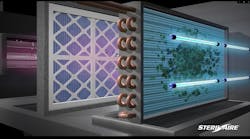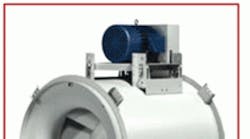Selecting a fan can be fairly complex. This article outlines the basic process for matching a fan to a system:
- Define the application.
- Select the basic fan.
- Determine fan size and operating-point location.
- Identify method of fan control.
Define the Application
The first step in selecting a fan is to define the application and system operating requirements in detail. Consider:
-
What the fan is supposed to do.
-
The location of the fan equipment. If the equipment is to be located outside, what are the ambient conditions (wind, temperature, moisture)?
-
The adequateness of space for maintenance and repair.
-
Facility limitations concerning weight, electrical capability, noise, and vibration.
-
Whether the fan will be ducted on the inlet, the outlet, or both.
-
Whether the fan will need to be controlled to meet changing system requirements.
-
Sound limitations, including inlet, outlet, and casing-radiated noise.
-
The number of fans in the system and whether redundancy is required.
Select the Basic Fan
Housing, impeller, and drive type are the most important considerations in basic fan selection.
Housing — inline vs. scrolled centrifugal
A fan's housing usually is dependent on the design of the system and whether or not the inlet and/or outlet is/are ducted. For a ducted, ceiling-hung fan, for instance, an inline housing (Photo A) is optimal because of its straight-through airflow profile and ability to be ducted on either end. In a high-temperature application, such as 750°F continuous duty, a scrolled-centrifugal housing (Photo B) is the better choice because the motor, bearings, belts, and sheaves are located outside of the air stream. With an inline fan, drive components usually are located at least partially in the air stream.
Impeller — axial, centrifugal, or mixed flow
Once a fan's housing is determined, its impeller can be chosen. Two basic types of impellers are axial (propeller) and centrifugal (wheel). Axial impellers typically are used in high-volume, low-pressure systems, in which they are more efficient than centrifugal impellers. Centrifugal impellers typically are used in high-pressure applications, as well as applications involving high-temperature or contaminated air; they are less affected by poor inlet conditions and unclean air than are axial impellers.
A third type of impeller — mixed flow — is a hybrid of centrifugal and axial impellers. In most inline-fan applications, the mixed flow impeller is the best option. Mixed flow impellers are capable of higher pressures than axial impellers and greater airflow than centrifugal impellers. Also, at pressures in excess of 1 in., they have lower sound levels, better sound quality, and — typically — higher efficiencies than axial and centrifugal impellers.
Drive type — direct vs. belt
Once impeller type is determined, drive type can be selected. Although the industry trend is toward direct-drive fans (Photo C), belt-drive fans (Photo D) are not without their benefits.
Direct-drive fans require less maintenance because of fewer moving parts. Also, they are easier to control with variable-frequency drives (VFDs) and can be more efficient, as they do not experience frictional belt loss.
Belt-drive fans typically have more performance flexibility because they can be selected at any speed. They can be used in high-temperature- or contaminated-air applications, as the motor usually is located outside of the air stream.
With larger fans, motor cost can be a crucial factor in deciding drive type. Larger fans typically run at lower speeds. With belt-drive fans, one can accomplish those speeds with a standard 1,800-rpm motor by adjusting the size of the sheaves. With direct-drive fans, 1,200- and 900-rpm motors can be cost-prohibitive.
For low-horsepower applications, direct-drive fans with electronically commutated motors (ECMs) often are a much better choice than belt-drive fans. ECMs can be selected at a wide range of speeds and are significantly more efficient than other single-phase motors.
Determine Fan Size and Operating-Point Location
An important consideration in fan sizing is the location of operating points on a fan's performance curves. Figure 1 shows a typical fan curve with a fan's corresponding total efficiency. The fan curve indicates how a fan will perform at various pressures at a constant speed. The fan's highest efficiency (shaded green) corresponds with the operating points located on the top half of the fan-pressure curve.
A fan operating higher on a fan curve generally is going to be more efficient and produce less sound than a fan operating lower on the curve. In Figure 2, fan curves for three sizes of a backward-inclined centrifugal fan are shown for the same operating point.
The smaller the fan selected for a particular level of performance, the faster the fan must run and, thus, the lower on the fan curve the fan operates. A comparison of the location of the operating point in Figure 2 to the standard fan curve in Figure 1 shows the smallest fan will be the least efficient and, consequently, produce more sound. Another result of the higher operating speed is the possibility of decreased bearing life from internal wear.
On the other hand, as the largest fan in Figure 2 shows, operating-point location is important when a fan is operated close to peak pressure. Variable-air-volume systems often require higher resistance at reduced airflow, causing the operating point to “ride up” the fan curve. Operating points always should be located to the right of peak pressure, in the stable portion of the curve, where the steepness of the fan curve is sufficient to prevent the fan from “hunting” for air.
Performance and system-duty cycle
Selecting the most appropriate fan requires outlining every operating point, as well as the length of time the system will run at each point. Operating points are defined by the required airflow, inlet and outlet static pressure, and air-stream properties.
When multiple performance points are defined for a system, creating a system-duty plot — a graph of all of the operating points at a common air density — is important. This makes superimposing fan-performance-curve information and evaluating basic fan selections easy. All required operating points must fall within the limits of the fan-performance curve; otherwise, the fan will be incapable of achieving the required performance. Figure 3 outlines the multiple operating points of a typical system.
In Figure 3, each of the operating points is within the capabilities of the chosen fan. If any of the operating points were located outside of the fan's performance capabilities (left of the surge line, below the minimum revolutions per minute, or above the maximum revolutions per minute), the selection would need to be re-evaluated and a new selection made.
Another consideration when sizing a fan is initial cost of the fan. Typically, the smallest fan will be the least expensive to purchase, but the most expensive to operate. Higher operating costs can represent a significant investment for a building owner over the life of a fan. To maximize cost savings, fans should be selected based on a life-cycle assessment.
Identify Method of Fan Control
Fan control refers to the method by which a fan-performance point is moved to attain a new airflow rate and/or pressure in response to a change in system requirements. System requirements can change as a result of process changes, variable-volume demand changes, and filter loading, among other things.
There are several ways to change fan performance in response to a change in system requirements. Inlet vane dampers can be used to lower a fan-performance curve and decrease airflow and power requirements. Typically, inlet vane dampers are used only when a decrease in airflow is required and static pressure needs to be kept constant. A more common and more efficient way of changing a fan-performance curve is to change the speed of the fan through the use of a VFD. With this method, fan performance will move along a system curve in accordance with the fan laws.
This file type includes high resolution graphics and schematics when applicable.
Summary
Defining the application and determining the system operating points is an essential first step in selecting the correct fan for an application. Establishing the fan housing, impeller, and drive type eliminates many fan configurations as options. Considering the relative location of the operating point on the fan curve aids in finding a balance between fan efficiency and first cost. It may be necessary to control the fan to respond to changing system requirements.
While a basic understanding of fan selection is required to match a fan to an application, most fan manufacturers have software designed to help users maximize the efficiency and cost-effectiveness of a fan solution.
Did you find this article useful? Send comments and suggestions to Executive Editor Scott Arnold at [email protected].
Molly Rehwaldt is an application engineer for centrifugal, vaneaxial, and industrial products for Greenheck Fan Corp. Her responsibilities include product support, marketing materials, and customer service. She has a degree in mechanical engineering from Michigan Technological University. Tim Mathson is a principal engineer for centrifugal, vaneaxial, and industrial products for Greenheck Fan Corp. His responsibilities include new-product development. He has a bachelor's degree in mechanical engineering from the University of Wisconsin-Madison and is an active member of American Society of Heating, Refrigerating and Air-Conditioning Engineers and Air Movement and Control Association International technical committees.
RELATED READING
For more on this topic, read "Fan Selection and Energy Savings" by Brian Mleziva, one of HPAC Engineering's 10 most-read articles of 2010. For the complete list of 10 most-read articles of 2010, go to http://bit.ly/ifImnr.










